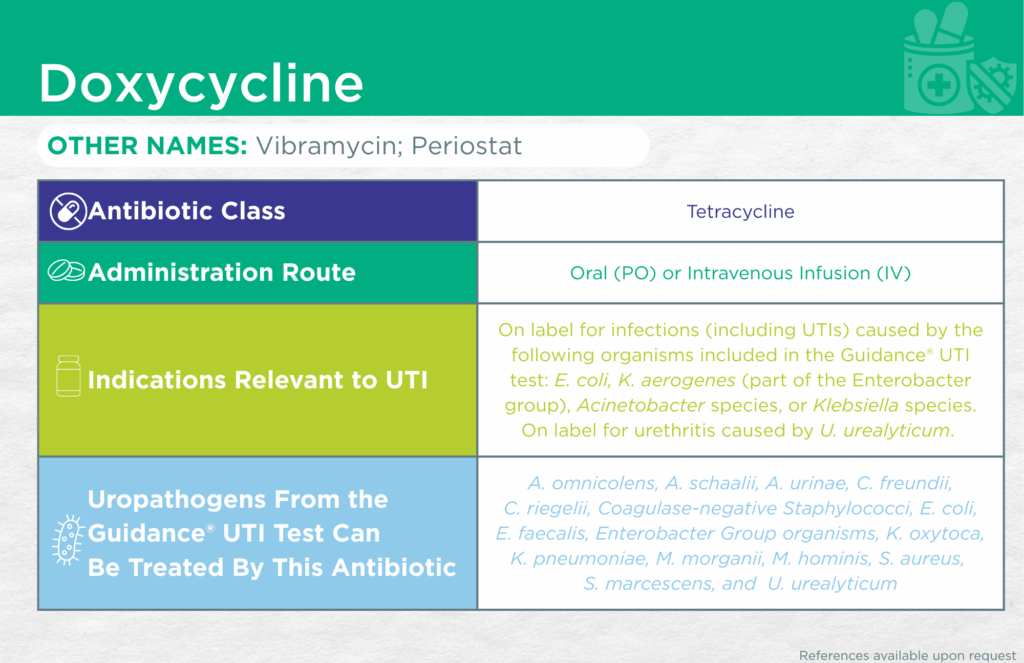Doxycycline

Emery Haley, PhD, Scientific Writing Specialist
Doxycycline
Find the Latest FDA-Approved Labelling Information Here: Drugs@FDA Online Database
Administrative Routes
Oral (PO) or Parenteral [intravenous infusion (IV)]
Other Names
Vibramycin; Periostat
Bacteriostatic or Bactericidal
Bacteriostatic [1]
Antibiotic Class
Tetracycline
Mechanisms of Action
The drug binds to the 30S ribosomal subunit of bacterial ribosomes. Binding to bacterial ribosomes blocks bacterial cells from synthesizing proteins required for growth.
WHO AWaRe Classification
Access [2]
Empiric Use Recommendations
No published guidance
Indication(s) Relevant to UTI
On label for infections (including UTIs) caused by the following organisms included in the Guidance® UTI test: Escherichia coli, Klebsiella aerogenes (part of the Enterobacter group), Acinetobacter species, or Klebsiella species.
On label for urethritis caused by Ureaplasma urealyticum.
Checkmarks
CLSI and/or FDA documents support the efficacy of this antibiotic against the following organisms from the Guidance® UTI test: Aerococcus urinae, Citrobacter freundii, Corynebacterium riegelii, Coagulase-negative Staphylococci, Escherichia coli, Enterococcus faecalis, Enterobacter Group organisms, Klebsiella oxytoca, Klebsiella pneumoniae, Morganella morganii, Mycoplasma hominis, Staphylococcus aureus, Serratia marcescens, and Ureaplasma urealyticum.
Published primary literature supports the efficacy of this antibiotic against the following organisms from the Guidance® UTI test: Alloscardovia omnicolens [3] and Actinotignum schaalii [4]
- Ishak, A.; Mazonakis, N.; Spernovasilis, N.; Akinosoglou, K.; Tsioutis, C. Bactericidal versus Bacteriostatic Antibacterials: Clinical Significance, Differences and Synergistic Potential in Clinical Practice. J. Antimicrob. Chemother. 2024, 80, 1–17, doi:10.1093/jac/dkae380
- AWaRe Classification of Antibiotics for Evaluation and Monitoring of Use, 2023 Available online: https://www.who.int/publications/i/item/WHO-MHP-HPS-EML-2023.04 (accessed on 6 February 2025).
- Isnard, C.; Lienhard, R.; Reissier, S.; Rodriguez, S.; Krähenbühl, J.; Liassine, N.; Guérin, F.; Cattoir, V. In Vitro Antimicrobial Susceptibility of Alloscardovia Omnicolens and Molecular Mechanisms of Acquired Resistance. Diagnostic Microbiology and Infectious Disease 2016, 84, 227–229, doi:10.1016/j.diagmicrobio.2015.08.009.
- Sahuquillo-Arce, J.M.; Suárez-Urquiza, P.; Hernández-Cabezas, A.; Tofan, L.; Chouman-Arcas, R.; García-Hita, M.; Sabalza-Baztán, O.; Sellés-Sánchez, A.; Lozano-Rodríguez, N.; Martí-Cuñat, J.; et al. Actinotignum Schaalii Infection: Challenges in Diagnosis and Treatment. Heliyon 2024, 10, e28589, doi:10.1016/j.heliyon.2024.e28589.
Dr. Emery Haley is a scientific writing specialist with over ten years of experience in translational cell and molecular biology. As both a former laboratory scientist and an experienced science communicator, Dr. Haley is passionate about making complex research clear, approachable, and relevant. Their work has been published in over 10 papers and focuses on bridging the gap between the lab and real-world patient care to help drive better health outcomes.